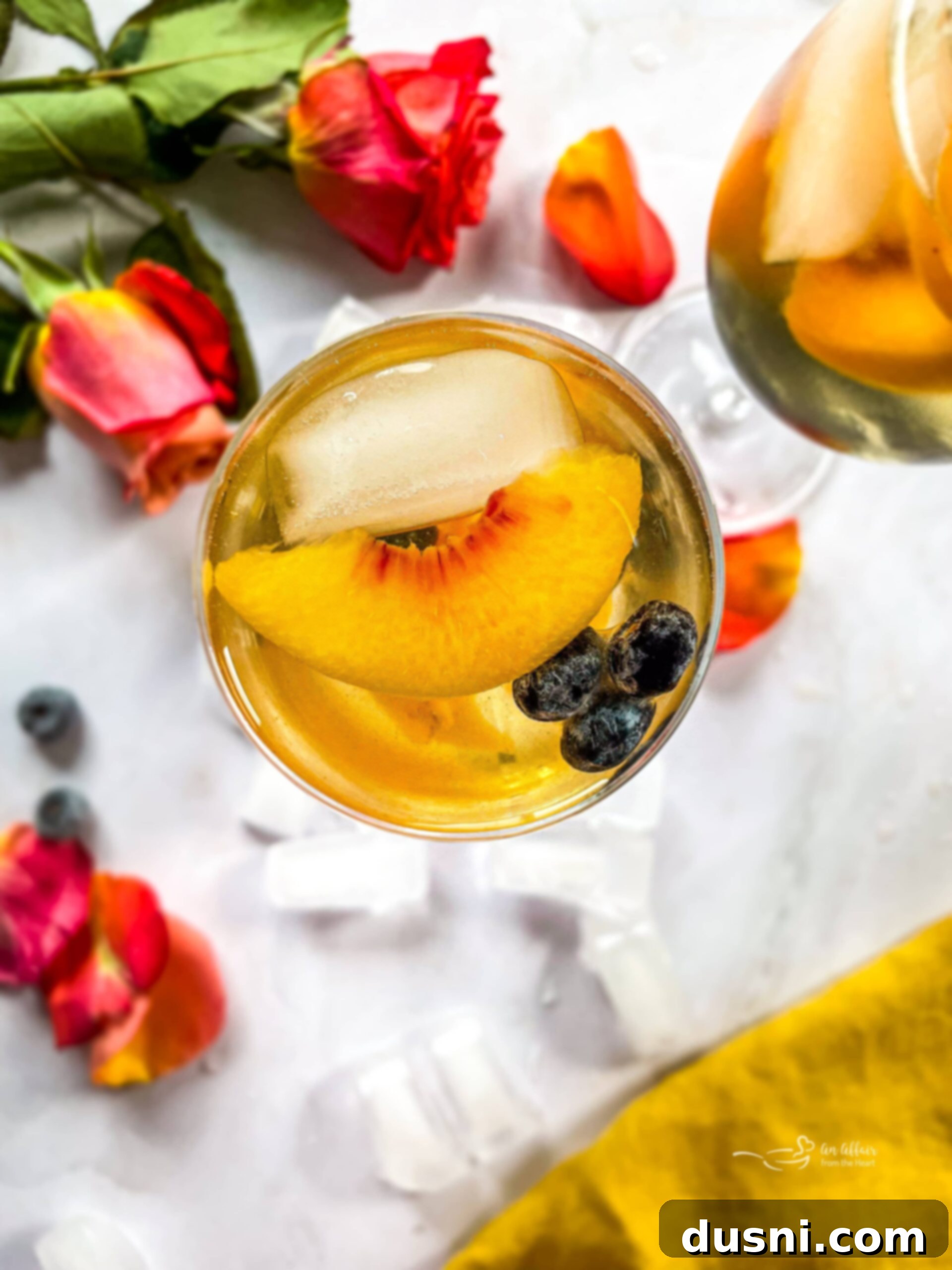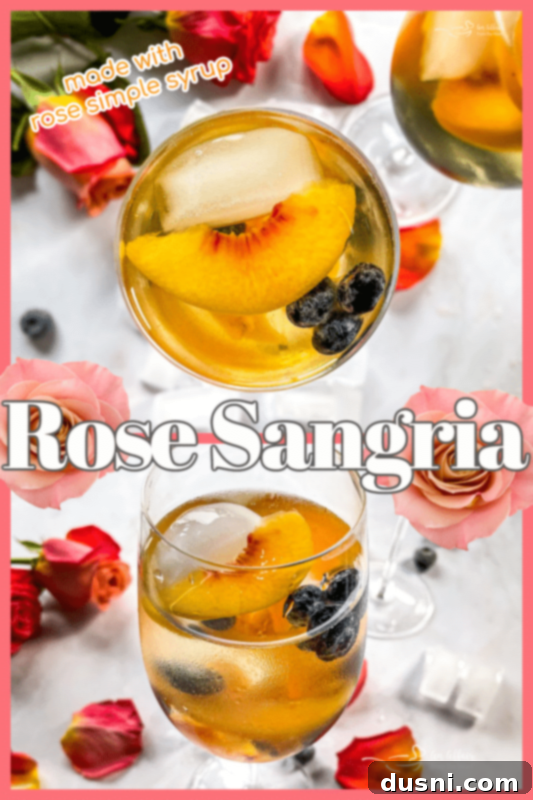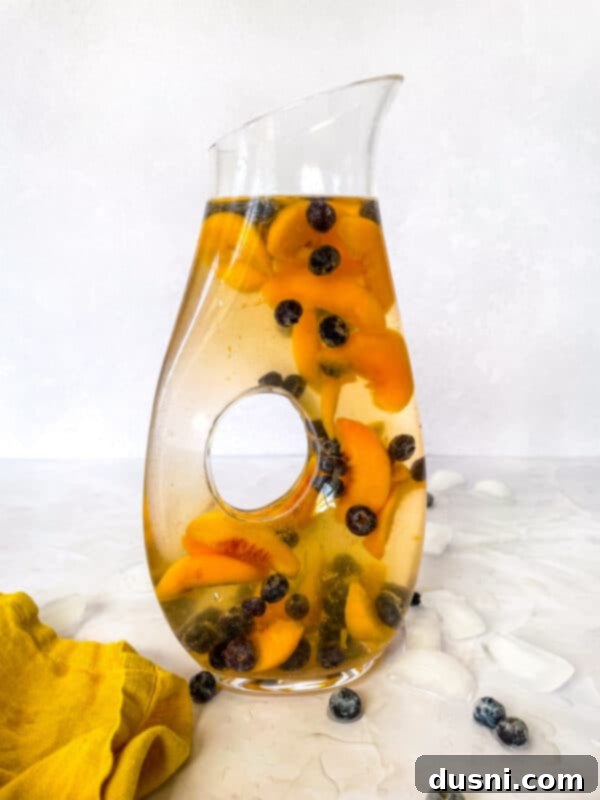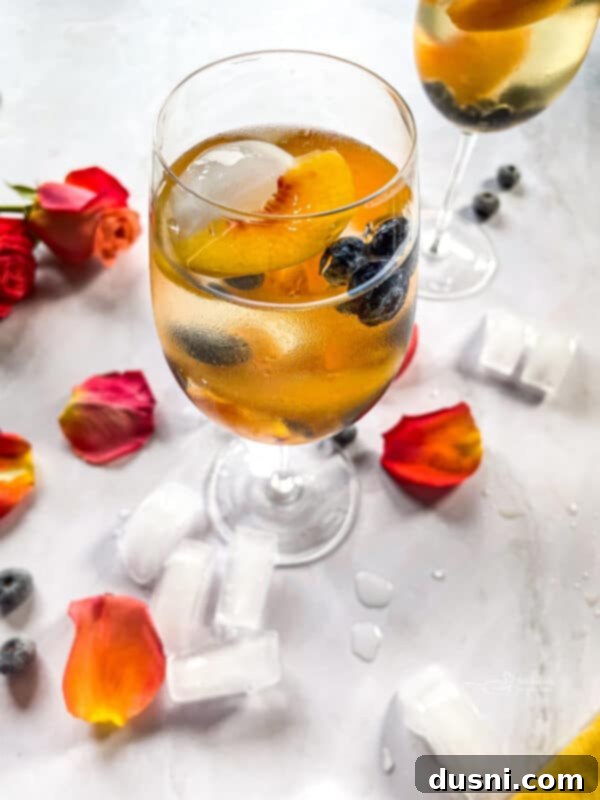Refreshing Rose Sangria Recipe: A Floral & Fruity Cocktail for Every Celebration
This exquisite Rose Sangria offers a unique twist on a classic, blending the delicate fragrance of real rose petals with crisp Sauvignon Blanc, an assortment of fresh fruits, and a delightful fizz from ginger ale. It’s a truly refreshing cocktail, perfect for special occasions, warm weather gatherings, or simply elevating a casual evening. Far from your typical Rosé Sangria, this recipe uses actual rose simple syrup, creating an aromatic and visually stunning drink that will impress your guests.

Imagine celebrating Mother’s Day, a bridal shower, or a lovely summer brunch with this beautiful libation in hand. While you’re picking up flowers for that special woman in your life, grab a few extra pesticide-free roses, and you’ll be well on your way to crafting this sensational beverage. What sets this Rose Sangria apart is its use of a crisp white wine, specifically Sauvignon Blanc, complemented by a homemade rose-infused simple syrup, then finished with ginger ale for those joyous, celebratory bubbles.
The beauty of sangria lies in its versatility. You can effortlessly customize this recipe to suit your preferences. Feel free to experiment with your favorite red or white wine, or even a dry rosé if you prefer a subtle pink hue from the wine itself. The fruit selection is also entirely up to you – whether it’s an abundance of fresh berries, vibrant citrus slices, or a convenient bag of frozen mixed fruit, this recipe is guaranteed to be a hit with minimal effort. It’s an adaptable drink that promises to delight with every sip.
Should you be on the hunt for more enticing cocktail creations, consider trying our Kiwi Mojito Recipe for a zesty, minty treat, our rich and creamy Homemade Irish Cream, or the classic, invigorating Moscow Mule. Each offers a distinct flavor profile, ensuring there’s a perfect drink for every palate and occasion.
The Charm of Rose Sangria
This Rose Sangria holds a special place in my heart, with its origins tracing back to one of my annual Valentine Girlfriend Brunches in 2012. It quickly became a beloved favorite, a recipe I’ve returned to countless times over the years. Each time, it delivers that same delightful floral and fruity essence. Today, on a warm Friday leading into Mother’s Day weekend, it felt like the absolute perfect moment to refresh this timeless recipe and share it once again. A pitcher of this vibrant sangria is truly what the weekend calls for, promising warmth, relaxation, and delicious sips.
The allure of this sangria lies not only in its taste but also in its captivating aroma and beautiful presentation. The subtle rose notes elevate the traditional sangria experience, making it feel more refined and luxurious. It’s an ideal choice for celebrations where you want to serve something a little out of the ordinary, yet incredibly approachable and enjoyable for everyone.
Key Ingredients for Making the Best Rose Sangria
For the precise measurements and step-by-step instructions, please refer to the printable recipe card located at the very bottom of this post. Here’s a deeper look into the components that make this sangria truly special:
- Granulated Sugar: Essential for creating the rose simple syrup. White granulated sugar dissolves beautifully, forming a clear, sweet base that carries the delicate rose flavor.
- Water: Used in conjunction with sugar to form the simple syrup. Regular tap water is perfectly fine, as it will be boiled to ensure the sugar fully dissolves.
- Large Rose Petals: This is the star ingredient that gives the sangria its unique “rose” character. I used peach-colored petals, but any color will work just as well and will not impact the flavor, though it might subtly influence the final hue of your sangria. Ensure your roses are food-grade and free from pesticides or chemicals if you’re using them from your garden. Specialty food stores or florists can often provide edible rose petals. The petals infuse the syrup with a gentle, aromatic essence, which is key to this recipe.
- Sauvignon Blanc Wine: My preferred choice for its crisp, dry profile and subtle citrus notes, which beautifully complement the floral rose and fresh fruit. However, this recipe is highly adaptable. Any dry white wine will work well. For those who prefer a different experience, a light-bodied red wine could be used for a deeper flavor, or a dry Rosé wine for a lovely pink hue directly from the wine itself, creating a different kind of “Rosé” sangria. The key is to choose a wine you enjoy drinking on its own.
- Fresh Fruit of Choice: The fruit adds natural sweetness, texture, and a burst of color. For this batch, I opted for juicy fresh peaches and sweet blueberries, which pair wonderfully with the rose and white wine. Other excellent choices include strawberries, raspberries, blackberries, sliced oranges, or even apples. Feel free to use a mix of your favorite seasonal fruits, or for convenience, a bag of frozen mixed fruit works perfectly and helps keep the sangria chilled without dilution.
- Ginger Ale: Added just before serving, ginger ale introduces a delightful effervescence and a subtle, spicy kick that brightens the entire drink. It creates those wonderful bubbles that make sangria so refreshing and festive.
How to Masterfully Prepare Your Rose Sangria

The creation of this Rose Sangria is divided into a few simple, yet crucial steps to ensure maximum flavor and enjoyment.
- **Crafting the Rose Simple Syrup:** Begin by combining water, sugar, and the fresh rose petals in a saucepan. Place it over medium heat and bring the mixture to a gentle boil, stirring occasionally until the sugar completely dissolves. Once boiling, remove the saucepan from the heat. This is where the magic happens – allow the rose petals to steep in the warm syrup for approximately 15 minutes. This steeping time is essential for the petals to release their delicate fragrance and flavor into the syrup.
- **Straining and Cooling:** After steeping, carefully remove the rose petals from the syrup. You can use a fine-mesh sieve or a slotted spoon for this. Discard the petals, and you are left with a beautifully aromatic rose simple syrup. Set this syrup aside and allow it to cool completely before proceeding to the next step.
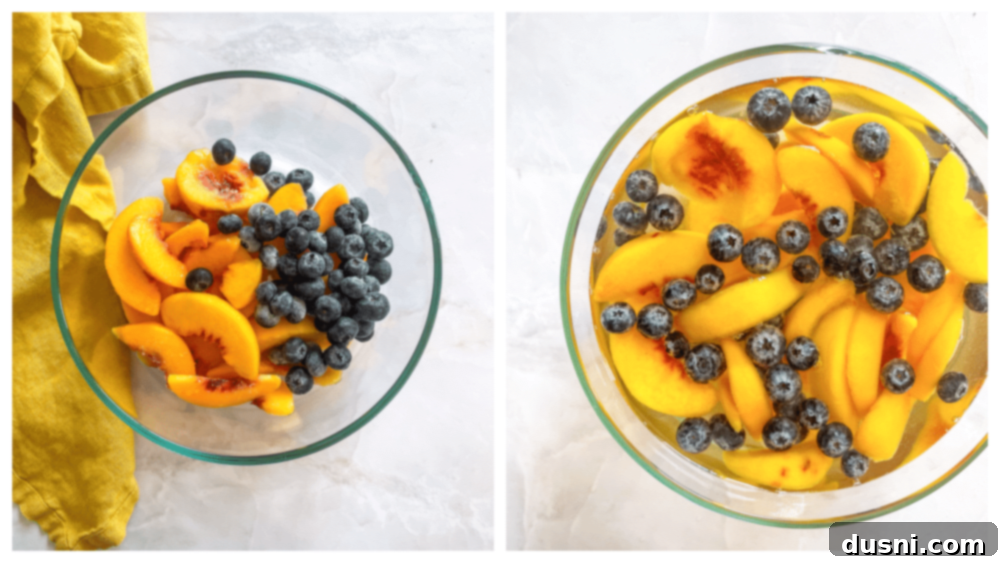
- **Assembling the Base:** While your simple syrup is cooling, prepare your chosen fresh fruit by cutting it into bite-sized pieces. Place the prepared fruit into an airtight container or a large pitcher. Once the rose simple syrup has cooled, pour it over the fruit, followed by the two bottles of Sauvignon Blanc wine.
- **The Crucial Chill (Infusion Time):** This step is non-negotiable for the best results! Securely cover your container and refrigerate the mixture for at least 24 hours. This extended chilling period allows the flavors to truly meld and deepen. The fruit will absorb the wine and rose syrup, becoming wonderfully infused, and the overall taste profile will develop a harmonious balance. You can give the mixture a gentle stir occasionally to help the flavors mingle even more effectively.
- **Final Touch & Serving:** When you are ready to serve your exquisite Rose Sangria, pour the infused fruit and wine mixture into a beautiful pitcher or a large punch bowl. Just before serving, add a can of chilled ginger ale over the top. The ginger ale provides a refreshing bubbly effect and a subtle spicy note that completes the sangria perfectly. Give it a gentle stir to combine, and garnish with extra fresh fruit or a few fresh rose petals for an elegant presentation.
Storage Tips: Any leftover Rose Sangria can be easily stored in the refrigerator for up to a week. Simply ensure the container is tightly covered with plastic wrap or a lid to maintain its freshness. While it’s tempting to preserve it longer, I do not recommend freezing this rose sangria, as it can affect the texture of the fruit and the overall integrity of the flavors.
Love it? Pin it!
If this delightful Rose Sangria recipe captures your heart, make sure you don’t let it slip away! Pin it to your favorite Pinterest recipe board before you leave so you can easily find it for your next gathering or moment of indulgence!
Frequently Asked Questions About Rose Sangria
-
What exactly is in Rose Sangria? This particular Rose Sangria recipe distinguishes itself by using a unique simple syrup made from water, sugar, and actual rose petals, rather than relying solely on Rosé wine. This infusion provides a delicate, authentic floral flavor and aroma.
-
What is pink sangria typically made of? Pink sangria generally derives its color from red wine, which is mixed with white wine or clear spirits to create a lighter, pinkish hue. Our Rose Sangria, while potentially pink depending on the chosen fruit or an optional Rosé wine, primarily gets its “rose” name from the rose petal simple syrup.
-
What’s the difference between red sangria and this Rose Sangria? Traditional red sangria is primarily made with red wine, offering a richer, bolder flavor profile. While “Rosé Sangria” typically refers to sangria made with rosé wine, our “Rose Sangria” recipe specifically incorporates rose petals (from the flower) to infuse a unique floral essence, setting it apart from standard wine-based sangrias.
-
Is sangria generally stronger than regular wine? Typically, no. Sangria is usually less potent than pure wine because it’s diluted with fruit juices, sparkling water, or in our case, ginger ale, along with a significant amount of fresh fruit. These additions decrease the overall alcohol content per serving compared to drinking undiluted wine.
- Can I use any color of rose petals for the simple syrup? Absolutely! The color of the rose petals will primarily affect the visual hue of your simple syrup and potentially the sangria itself, making it subtly pinker or golden. However, the delicate rose flavor will remain consistent regardless of the petal color, so feel free to use what’s available and beautiful. Just ensure they are food-grade and pesticide-free.
- Is it possible to make this sangria without alcohol? Yes, you can easily adapt this recipe to be alcohol-free. Simply substitute the Sauvignon Blanc wine with an equal amount of sparkling cider, white grape juice, or a non-alcoholic white wine. The rose simple syrup and fresh fruit will still provide a delicious and refreshing base.
- How long does Rose Sangria need to chill? For the best flavor development, we highly recommend refrigerating the sangria mixture (wine, simple syrup, and fruit) for a full 24 hours. This allows all the flavors to marry beautifully, creating a more complex and enjoyable drink.
Creative Substitutions and Variations
This Rose Sangria recipe is incredibly flexible, allowing for numerous substitutions and additions to tailor it to your taste or what you have on hand:
-
Wine Choices: While Sauvignon Blanc is recommended, feel free to change up the wine. Sparkling wines like Prosecco or Cava can add extra effervescence and a festive touch (add these just before serving). For a more robust flavor, opt for a light-bodied red wine to create a floral red sangria. For a non-alcoholic version, non-alcoholic wine or even white grape juice are excellent alternatives.
-
Added Juices: Stir in a splash of fruit juice like crisp apple juice, tropical pineapple juice, or even white cranberry juice to enhance the fruit flavors and add another layer of sweetness.
-
Sparkling Additions: Instead of ginger ale, you can use sparkling water, club soda, lemon-lime soda (like 7Up or Sprite), or even tonic water to give the sangria its delightful fizz. Each will impart a slightly different flavor profile.
-
Diverse Fresh Fruits: Expand your fruit medley! Mix in vibrant orange slices, luscious strawberries, tangy raspberries, juicy blackberries, or even sliced apples and pears. The more variety, the more complex and visually appealing your sangria will be.
-
Citrus Boost: For a brighter, more zesty flavor, squeeze in a touch of fresh lemon juice, lime juice, or orange juice. This can really awaken the other flavors in the sangria.
-
Liqueur Enhancements: For those who enjoy a bit more complexity and a slight increase in alcohol content, consider adding a splash of Triple Sec, Grand Marnier, Cointreau, or any other orange liqueur. Peach schnapps or elderflower liqueur would also be harmonious additions.
-
Warm Spices: For a unique twist, especially in cooler months or for a holiday gathering, infuse the sangria with warm spices. A cinnamon stick or a split vanilla bean steeped with the wine and fruit can add incredible depth and comfort.
-
Elegant Garnishes: Beyond fresh fruit, garnish your sangria with fresh herbs like a sprig of mint, basil, or even a few edible orchid petals for an extra touch of elegance and aroma.
Essential Tips & Tricks for the Perfect Rose Sangria
-
Don’t Skimp on Chilling Time: For the most harmonious and developed flavors, strictly adhere to the recommended 24-hour refrigeration period. The delicate notes of rose and fruit need ample time to properly infuse and marry with the wine. Rushing this step will result in a less complex and enjoyable sangria.
-
Fresh vs. Frozen Fruit: While fresh fruit is always lovely for its texture and vibrant appearance, if fresh isn’t readily available or in season, frozen fruit is a perfectly acceptable substitute. In fact, frozen fruit can act as natural ice cubes, helping to keep your sangria perfectly chilled without diluting the flavors as ice cubes would.
-
Edible Rose Petals are Key: When sourcing rose petals, ensure they are food-grade and free from any pesticides or chemical treatments. This is crucial for both safety and taste. Organic roses from a reputable florist or your own garden (if untreated) are ideal.
-
Chill All Ingredients: For the coldest, most refreshing sangria, make sure your wine, simple syrup (once cooled), and especially your ginger ale are well-chilled before mixing and serving. This enhances the overall experience.
-
Serve in a Large Pitcher: A clear, large pitcher or punch bowl not only makes for a beautiful presentation, allowing the colorful fruits and rose petals to shine, but also makes serving easier for a crowd.
More Recipes to Love and Explore
If you’re enchanted by the idea of incorporating floral notes into your culinary adventures, here are more fun ways to use rose petals or rose water in the kitchen:
- Rose Champagne Cocktail: For another sparkling floral delight.
- Rose Ice Cream: A surprisingly refreshing and aromatic dessert.
- Homemade Rose Water: Perfect for baking, cocktails, and even beauty uses.
- Rose White Hot Chocolate: A comforting, fragrant twist on a classic warm beverage.
For those looking to entertain a crowd or simply enjoy a generous batch of deliciousness, here are a couple more of my favorite large-batch cocktails, perfect for your next celebration:
- Blueberry Margaritas: A vibrant and fruity take on a beloved classic.
- Frozen Vodka Slush: An incredibly refreshing and easy-to-make frozen cocktail.
- Brazilian Lemonade: A creamy, zesty, and unique lemonade that feels like a mini-vacation.
If you love the concept of using flowers to add delightful flavors and aromas to your kitchen creations, don’t miss these other inspiring recipes:
- Lavender Shortbread with Strawberries and Cream: A delicate and fragrant dessert.
- How To Flavor Sugars: Learn to infuse sugars with various essences for baking and beverages.
- Homemade Sugar Scrubs: While not strictly edible, this recipe highlights the versatility of natural ingredients, much like our rose petals!

A warm summer day practically begs for a generous pitcher of this Rose Sangria. It’s time to set aside your old classic sangria recipe and embrace this wonderfully unique and flavorful drink. It truly offers a delightful and elegant alternative to traditional white sangria or red sangria, bringing an unexpected floral elegance to your glass.
Whether you’re celebrating Mother’s Day, planning a special anniversary, hosting a festive Christmas morning brunch, or simply enjoying a relaxing girls’ night in, you simply cannot go wrong with this absolutely delicious beverage. Its unique fruity and floral flavor profile makes it a standout choice for any occasion, leaving a lasting impression on all who try it.
Now that the beautiful warm weather has arrived, seize the opportunity to whip up a large pitcher of this rose-infused sangria. It’s the perfect way to cool down, celebrate, and indulge in a truly special drink. Cheers to you and yours for enjoying such a delightful and refreshing creation!

LIKE THIS RECIPE?
Don’t forget to give it a ⭐️⭐️⭐️⭐️⭐️ star rating and
leave a comment below the recipe!

Print Recipe
Rose Sangria
Equipment
-
HAKEEMI Wine Glasses Set of 12
-
Mikasa Napoli Glass Beverage Pitcher
Ingredients
- 2/3 cup sugar
- 2/3 cup water
- the petals of 1 large food-grade rose (any color works, ensure pesticide-free)
- 2 bottles of Sauvignon Blanc Wine (or other dry white wine, rosé, or non-alcoholic wine)
- 4 cups mixed fruit (fresh or frozen, such as peaches, blueberries, strawberries, oranges)
- 1 can ginger ale (chilled)
Instructions
-
In a saucepan over medium heat, bring the water, sugar, and rose petals to a gentle boil, stirring until the sugar is dissolved.
-
Remove from heat and let the petals steep in the syrup for about 15 minutes to infuse their delicate flavor.
-
Remove and discard the petals, then set aside the rose simple syrup to cool completely.
-
Cut up your chosen fruit and place it into a large airtight container or pitcher.
-
Pour the cooled rose simple syrup and both bottles of Sauvignon Blanc wine over the fruit.
-
Refrigerate the mixture for a minimum of 24 hours to allow the flavors to fully develop and meld. Stir occasionally if desired.
-
Just before serving, pour the infused sangria into a pitcher or punch bowl. Add one can of chilled ginger ale over the top for a delightful bubbly effect. Stir gently and serve immediately with fresh fruit garnishes.
Notes
Storage: Leftover Rose Sangria can be stored in the refrigerator for up to a week. Ensure the container is tightly covered with plastic wrap or a lid. Freezing is not recommended as it can negatively impact the texture of the fruit and the overall quality of the drink.
Nutrition
I first crafted this Rose Sangria recipe and shared it on February 27, 2012. It has since been updated with enhanced details, new photos, and improved user experience, and was most recently reshared on May 12, 2023.
